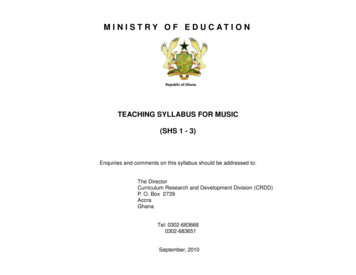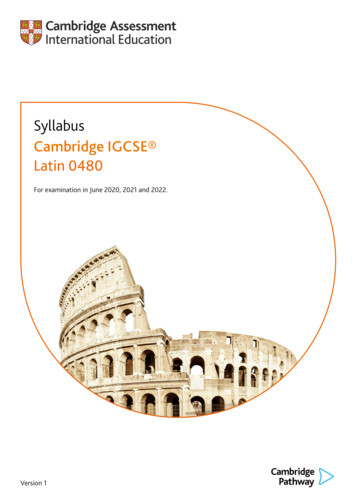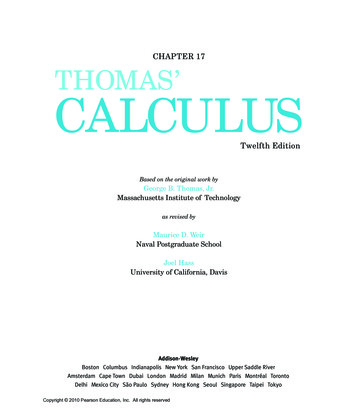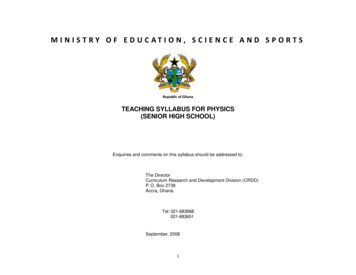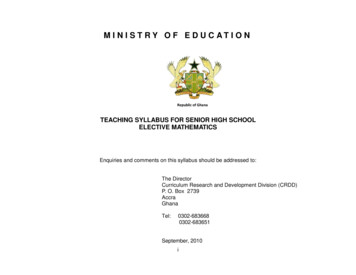
Transcription
M I N I S T R Y O F E D U C AT I O NRepublic of GhanaTEACHING SYLLABUS FOR SENIOR HIGH SCHOOLELECTIVE MATHEMATICSEnquiries and comments on this syllabus should be addressed to:The DirectorCurriculum Research and Development Division (CRDD)P. O. Box 2739AccraGhanaTel:0302-6836680302-683651September, 2010i
RATIONALE FOR TEACHING ELECTIVE MATHEMATICSThe abilities to read, analyze and calculate are the three fundamental skills that are vital for living and working. The level of mathematics one may study dependsupon the type of work or profession one may choose in life and on one‟s aptitude and interest. Elective mathematics deals with reasoning by analogies, makingjudgments through discrimination of values, analysis of data, and communication of one‟s thoughts through symbolic expression and graphs.Elective Mathematics at the Senior High School level builds on the Core Mathematics of Senior High School. It is a requirement as foundation for those who wouldwish to embark on professional studies in engineering, scientific research, and a number of studies in tertiary and other institutions of higher learning.GENERAL AIMSThe syllabus is designed to help students to:12345appreciate the use of mathematics as a tool for analysis, critical and effective thinking.discover order, patterns and relations.communicate their thoughts through symbolic expressions and graphs.develop mathematical abilities useful in commerce, trade and public service.make competent use of ICT in problem solving and investigation of real life situations.SCOPE OF CONTENTElective mathematics covers the following content areas:1. Algebra2. Coordinate Geometry3. Vectors and Mechanics4. Logic5. Trigonometry6. Calculus7. Matrices and Transformation8. Statistics and ProbabilityPRE-REQUISITE SKILLS AND ALLIED SUBJECTSSuccess in the study of Elective Mathematics requires proficiency in English Language and in Core Mathematics. Other subjects that may help the effective studyof Elective Mathematics include Physics and Technical Drawing.ii
ORGANIZATION OF THE SYLLABUSThis syllabus has been structured to cover the three (3) years of Senior High School. Each year‟s work consists of a number of sections with each sectioncomprising a number of units.The unit topics for the three years course are indicated in the table below.SCOPE AND SEQUENCE FOR SHS ELECTIVE MATHEMATICSSHS1SHS2SHS31.Sets (pg 1)Coordinate Geometry 2 (pg 14-16)Matrices (pg 39 - 41)2.Surds (pg 1 - 2 )Sequences and Series (pg 17-18)Linear Transformations (pg 41 - 43)3.Binary Operations (pg 3)Indices and Logarithms (pg 18 - 19)Logic (pg 44)4.Relations and Functions (pg 3 - 4)Trigonometric Ratios and Rules (pg 20 - 21)Correlation and Regression (pg 45 - 47)5.Polynomial Functions (pg 4 - 7)Compound and Multiple Angles (pg 21 - 22)Spearman‟s Rank Correlation (pg 45 - 47)6.Rational Functions (pg 7)Trigonometric Functions/Equations (pg 22)Dynamics (pg 48 - 49)7.Binomial Theorem (pg 7- 8)Differentiation (pg 23 - 24)8.Inequalities and Linear Programming (pg 8)Application of Differentiation (pg 24 - 25)9.Coordinate Geometry I (pg 9-10)Integration (pg 26)10.Probability I (pg 11)Application of Integration (pg 26 - 27)11.Vectors I (pg 12 - 13)Permutation and Combinations (pg 28)12.Probability II (pg 29)13.Statistics I (pg 30 - 32)14.Application of vectors in Geometry (pg 33 - 35)15.Statics (pg 36 - 38)TIME ALLOCATIONElective Mathematics is allocated six periods a week, each period consisting of forty (40) minutes.iii
SUGGESTIONS FOR TEACHING THE SYLLABUSThis syllabus has been planned to incorporate almost all branches of mathematics: - Algebra, Logic, Trigonometry, Coordinate Geometry, Calculus, LinearTransformation, Vectors, Mechanics, Statistics and Probability. In a broad framework of this nature, schools will have to adopt team teaching approach for thiscourse. Besides, the teacher‟s attention is drawn to the use of calculators and ICT in teaching of Elective mathematics.The syllabus has been built on the core mathematics syllabus. It is therefore necessary for the student to have sound foundation in core mathematics. Teachersare advised to read through the entire syllabus in order to appreciate its scope and demands. Again, teachers are to link up the core and elective syllabuses whendealing especially with the topics.General ObjectivesGeneral objectives have been listed at the beginning of each section. The general objectives are linked to the General Aims of this subject and specify the skillsand behaviours the student should acquire after learning the units of a section.Section and UnitsThe syllabus has been planned on the basis of sections and units. Each year‟s work is divided into sections. A section consists of a number of units and specificobjectives.The syllabus is structured in five columns: Unit, Specific objectives, Content, Teaching and Learning Activities and Evaluation. A description of the contents ofeach column is as follows:Column 1 – UnitsThe units in column 1 are the major topics of the section. The numbering of the units is different from the numbering adopted in other syllabuses. The unitnumbers consist of two digits. The first digit shows the year or class, while the second digit shows the number of the unit. A unit number like 2.1 is interpreted asUnit 1 of SHS 2. Similarly a unit number like 3.4 means Unit 4 of SHS3. This type of unit numbering has been adopted to ensure that the selected topics andskills are taught appropriately in the suggested sequence. The order in which the units are arranged is just to guide you plan your work. If however, you find atsome point that teaching and learning in your class will be more effective if you branch to another unit before coming back to the unit in the sequence, you areencouraged to do so. It is hoped that no topics will be glossed over for lack of time, because it is not desirable to create gaps in students‟ knowledge.Column 2 – Specific ObjectivesColumn 2 shows the specific objectives for each unit. The specific objectives in this syllabus begin with numbers such as 2.1.3 or 3.2.1. These numbers arereferred to as “Syllabus Reference Numbers” – SRN. The first digit in this elective mathematics syllabus reference number refers to the year of the SHS class; thesecond digit refers to the unit, while the third digit refers to the rank order of the specific objective.For example, 2.1.3 means SHS2, unit1 and specific objective 3. In other words 2.1.3 refers to specific objective 3 of unit 1 of SHS2. Similarly, the syllabusreference number 3.2.1. simply means syllabus objective Number 1 of unit 2 at SHS3. Using syllabus reference numbers provides an easy way for communicationamong teachers and other educators. It further provides an easy way for selecting objectives for test construction. For instance, if a unit has five specificobjectives 2.4.1 – 2.4.5, the teacher may want to base his/her questions on objectives 2.4.3 to 2.4.5 and not use the other first two specific objectives. In this wayiv
a teacher would sample the objectives within units and within the year to be able to develop a test that accurately reflects the importance of the various conceptsand skills taught in class.You will note also that specific objectives have been stated in terms of the student, - i.e., what the student will be able to do during and after instruction andlearning in the unit. Each specific objective hence starts with the following “The student will be able to” This in effect means that the teacher has to address thelearning problems of each individual student. It means individualizing your instruction as much as possible such that the majority of students will be able to masterthe objectives of each unit of the syllabus.Column 3 – Content: The “content” in the third column of the syllabus presents a selected body of information that you will need to use in teaching the particularunit. In some cases, the content presented is quite exhaustive. In other cases, you could add more information to the content presented.Column 4 – Teaching and Learning Activities (T/LA): T/LA activities that will ensure maximum student participation in the lessons are presented in column 4.Avoid instrumental learning and drill-oriented methods and rather emphasize participatory teaching and learning, and also emphasize the cognitive, affective andpsychomotor domains of knowledge in your instructional system wherever appropriate. You are encouraged to re-order the suggested teaching and learningactivities and also add to them where necessary in order to achieve optimum student learning.A suggestion that will help your students acquire the habit of analytical thinking and be able to apply their knowledge to problems is to begin each lesson with areal life problem. Select a real life or practical problem for each lesson. The selection must be made such that students can extend the knowledge gained in theprevious lesson and other generic skills to new situations not specifically taught in class. This is to enable students see the relevance of mathematics to real lifesituation. At the beginning of a lesson, state the problem, or write the problem on the board. Let students apply (George Polya‟s) problem solving techniques,analyze the problem, suggest solutions, etc., criticize solutions offered, justify solutions and evaluate the worth of possible solutions. There may be a number ofunits where you need to re-order specific objectives to achieve required learning effects.Column 5 – Evaluation: Suggestions and exercises for evaluating the lessons of each unit are indicated in Column 5. Evaluation exercises can be in the form oforal questions, quizzes, class assignments, structured questions, project work, etc. Try to ask questions and set tasks and assignments that will challenge yourstudents to apply their knowledge to issues and problems and engage them in developing solutions and developing positive attitudes towards the subject as aresult of having undergone instruction in this subject. The suggested evaluation tasks are not exhaustive. You are encouraged to develop other creativeevaluation tasks to ensure that students have mastered the instruction and behaviour implied in the specific objectives of each unit.Lastly, bear in mind that the syllabus cannot be taken as a substitute for lesson plans. It is, therefore, necessary that you develop a scheme of work and lessonplans for teaching the units of this syllabus.DEFINITION OF PROFILE DIMENSIONSA central aspect of this syllabus is the concept of profile dimensions that should be the basis for instruction and assessment. A „dimension‟ is a psychological unitfor describing a particular learning behaviour. More than one dimension constitute a profile of dimensions. A specific objective such as follows: “The student willbe able to describe ” etc., contains an action verb “describe” that indicates what the student will be able to do after teaching has taken place. Being able to“describe” something after the instruction has been completed means that the student has acquired “knowledge”. Being able to explain, summarize, giveexamples, etc. means that the student has understood the lesson taught. Similarly, being able to develop, plan, construct etc, means that the student has learnt tocreate, innovate or synthesize knowledge. Each of the specific objectives in this syllabus contains an “action verb” that describes the behaviour the student will beable to demonstrate after the instruction. “Knowledge”, “Application”, etc. are dimensions that should be the prime focus of teaching and learning in schools.Instruction in most cases has tended to stress knowledge acquisition to the detriment of other higher level behaviours such as application, analysis, etc. Thev
importance of learning is to help students to be able to apply their knowledge, develop analytical thinking skills, synthesize information, and use their knowledge ina variety of ways to deal with learning problems and issues in life. Each action verb indicates the underlying profile dimension of each particular specific objective.Read each objective carefully to know the profile dimension toward which you have to teach.Profile dimensions describe the underlying behaviours for teaching, learning and assessment. In Elective Mathematics, the two profile dimensions that have beenspecified for teaching, learning and testing are:Knowledge and UnderstandingApplication of Knowledge30%70%Each of the dimensions has been given a percentage weight that should be reflected in teaching, learning and testing. The weights, indicated on the right of thedimensions, show the relative emphasis that the teacher should give in the teaching, learning and testing processes. The focus of this syllabus is to get studentsnot only to acquire knowledge but also to understand what they have learnt and apply them in practical situations.The explanation and key words involved in each of the dimensions are as follows:Knowledge and Understanding (KU)KnowledgeThe ability to:Remember information, recognize, retrieve, locate, find, do bullet pointing, highlight, bookmark, network socially, bookmark socially,search, google, favourite, recall, identify, define, describe, list, name, match, state principles, facts and concepts. Knowledge is simply theability to remember or recall material already learned and constitutes the lowest level of learning.UnderstandingThe ability to:Interpret, explain, infer, compare, explain, exemplify, do advanced searches, categorize, comment, twitter, tag, annotate, subscribe,summarize, translate, rewrite, paraphrase, give examples, generalize, estimate or predict consequences based upon a trend.Understanding is generally the ability to grasp the meaning of some material that may be verbal, pictorial, or symbolicApplication of Knowledge (AK)The ability to use knowledge or apply knowledge, as implied in this syllabus, has a number of learning/behaviour levels. These levels include application, analysis,innovation or creativity, and evaluation. These may be considered and taught separately, paying attention to reflect each of them equally in your teaching. Thedimension “Applying Knowledge” is a summary dimension for all four learning levels. Details of each of the four sub levels are as follows:ApplicationThe ability to:Apply rules, methods, principles, theories, etc. to concrete situations that are new and unfamiliar. It also involves the ability to produce,solve, operate, demonstrate, discover, implement, carry out, use, execute, run, load, play, hack, upload, share, edit etc.AnalysisThe ability to:Break down a piece of material into its component parts, to differentiate, compare, deconstruct, attribute, outline, find, structure, integrate,mash, link, validate, crack, distinguish, separate, identify significant points etc., recognize unstated assumptions and logical fallacies,recognize inferences from facts etc.vi
Innovation/CreativityInnovation or creativity involves the ability to:Put parts together to form a novel, coherent whole or make an original product. It involves the ability to combine, compile, compose,devise, construct, plan, produce, invent, devise, make, program, film, animate, mix, re-mix, publish, video cast, podcast, direct, broadcast,suggest an idea or possible ways, revise, design, organize, create, and generate new ideas and solutions. The ability to innovate or createis the highest form of learning. The world becomes more comfortable because some people, based on their learning, generate new ideasand solutions, design and create new things.Evaluation -The ability to appraise, compare features of different things and make comments or judgments, contrast, criticize, justify, hypothesize,experiment, test, detect, monitor, review, post, moderate, collaborate, network, refractor, support, discuss, conclude, makerecommendations etc. Evaluation refers to the ability to judge the worth or value of some material based on some criteria and standards.Evaluation is a constant decision making activity. We generally compare, appraise and select throughout the day. Every decision we makeinvolves evaluation. Evaluation is a high level ability just as application, analysis and innovation or creativity since it goes beyond simpleknowledge acquisition and understanding.The action verbs provided under the various profile dimensions and in the specific objectives of the syllabus should help you to structure your teaching such as toachieve the effects needed. Select from the action verbs provided for your teaching, in evaluating learning before, during and after the instruction. Use the actionverbs also in writing your test questions.FORM OF ASSESSMENTIt must be emphasized again that it is important that both instruction and assessment be based on the profile dimensions of the subject. In developing assessmentprocedures, select specific objectives in such a way that you will be able to assess a representative sample of the syllabus objectives. Each specific objective inthe syllabus is considered a criterion to be achieved by the student. When you develop a test that consists of items or questions that are based on arepresentative sample of the specific objectives taught, the test is referred to as a “Criterion-Referenced Test”. In many cases, a teacher cannot test all theobjectives taught in a term, in a year, etc. The assessment procedure you use i.e. class tests, home work, projects, etc. must be developed in such a way that itwill consist of a sample of the important objectives taught over a period.The example below shows an examination consisting of two papers, Paper 1 and Paper 2. School Based assessment has been added to the structure. Paper 1will usually be an objective-type paper; Paper 2 will consist of structured questions demanding higher order thinking, and school based assessment will consist anumber of tasks. The distribution of marks for the questions in the two papers should be in line with the weights of the profile dimensions already indicated and asshown in the last column of the table below.The West African Examinations Council (WAEC) generally sets about 40 objective test items at the WASSCE. Use this as a guide to develop an objective testpaper (Paper 1) that consists of 40 items. Paper 2 could consist of some structured questions and more demanding questions put in sections. In general, letstudents answer the compulsory section and at least four questions from ten questions put in three parts in Paper 2.In the sample assessment structure presented below, Paper 1 is marked out of 100; Paper 2 is marked out of 100 and school based assessment is marked out of60, giving a total of 260 marks. Depending upon the school‟s examination and marking systems, you could use a total mark convenient to the teacher and theschool. Bear in mind of course, that using a different total mark will change the mark allocations for the test papers, etc.vii
The last row shows the weight of the marks allocated to each of the four test components. The two papers and SBA are weighted differently. Paper 1, theobjective test paper is weighted 20%. Paper 2 is a more intellectually demanding paper and is therefore weighted more than the objective test paper. Paper 2 isdesigned to test mainly application of knowledge. Papers 2 and the SBA are weighted 30%, and 50% respectively.Distribution of Examination Paper Weights and MarksPaper 1Paper 2School BasedAssessmentTotal Marks% Weight ofDimensionKnowledge and Understanding3030187830Application of Knowledge70704218270Total Marks10010060260-% Contribution of Paper203050-100DimensionsYou will note that Paper 1 has a contribution of 20% to the total marks; Paper 2 has a contribution of 30% to the total marks and SBA has a contribution of 50% tothe total marks. The numbers in the cells indicate the marks to be allocated to the items/questions that test each of the dimensions within the respective papers.The last but one column shows the total marks allocated to each of the dimensions. The numbers in this column are additions of the numbers in the cells and theyagree with the profile dimension weights indicated in the last column. Of the total marks of 210, the 78 marks for Knowledge and Understanding is equivalent to30%. The 182 marks for “Application” is equivalent to 70% of the total marks.Item Bank: Obviously the structure of assessment recommended in this syllabus will need a lot of work on the part of the teacher. In preparation for settingexamination papers, try to develop an item bank. The term “item bank” is a general term for a pool of objective items, and essay questions. As you teach thesubject, try to write objective test items, essay questions and structured essay questions To fit selected specific objectives which you consider important to betested. If you proceed diligently, you will realize you have written more than 100 objective test items, and more than 30 essay questions in a space of one year.Randomly select from the item bank to compose the test papers. Select with replacement. This means, as items/questions are selected for testing, new oneshave to be written to replace those items/questions already used in examinations. Items and questions that have been used in examinations may also be modifiedand stored in the item bank.An important issue in the preparation for a major examination such as the WASSCE, is the issue of test wiseness. To be „test wise‟ means that the student knowsthe mechanics for taking a test. These mechanics include writing the index number and other particulars accurately and quickly on the answer paper; reading allquestions before selecting the best questions to answer; apportioning equal time to each question or spending more time on questions that carry more marks;making notes on each question attempted before writing the answer; leaving extra time to read over one‟s work; finally checking to see that the personalparticulars supplied on the answer sheet are accurate. Some good students sometimes fail to do well in major examinations because of weakness in themechanics of test taking; because they are not test wise. Take your final year students through these necessary mechanics so that their performance in majorexaminations may not be flawed by the slightest weakness in test taking.viii
GUIDELINES FOR SCHOOL-BASED ASSESSMENT (SBA)A new School Based Assessment system (SBA) will be introduced into the school system in 2011. The new SBA system is designed to provide schools with aninternal assessment system that will help schools to achieve the following purposes:oooooooStandardize the practice of internal school-based assessment in all Senior High Schools in the countryProvide reduced assessment tasks for subjects studied at SHSProvide teachers with guidelines for constructing assessment items/questions and other assessment tasksIntroduce standards of achievement in each subject and in each SHS classProvide guidance in marking and grading of test items/questions and other assessment tasksIntroduce a system of moderation that will ensure accuracy and reliability of teachers‟ marksProvide teachers with advice on how to conduct remedial instruction on difficult areas of the syllabus to improve class performance.SBA may be conducted in schools using the following: Mid-term test, Group Exercise, End-of-Term Test and Project1.Project: This will consist of a selected topic to be carried out by groups of students for a year. Segments of the project will be carried out each term towardthe final project completion at the end of the year. The projects may include the following:i)experimentii)investigative study (including case study)\iii)practical work assignmentA report must be written for each project undertaken.2.Mid-Term Test: The mid-term test following a prescribed SBA format3.Group Exercise: This will consist of written assignments or practical work on a topic(s) considered important or complicated in the term‟s syllabus4.End-of-Tem Test: The end –of-term test is a summative assessment system and should consist of the knowledge and skills students have acquired in theterm. The end-of-term test for Term 3 for example, should be composed of items/questions based on the specific objectives studied over the three terms,using a different weighting system such as to reflect the importance of the work done in each term in appropriate proportions. For example, a teacher maybuild an End-of-Term 3 test in such a way that it would consist of the 20% of the objectives studied in Term 1, 20% of objectives studied in Term 2 and60% of the objectives studied in Term 3.ix
GRADING PROCEDURETo improve assessment and grading and also introduce uniformity in schools, it is recommended that schools adopt the following WASSCE grade structure forassigning grades on students‟ test results. The WASSCE structure is as follows:Grade A1:Grade B2:Grade B3:Grade C4:Grade C5:Grade C6:Grade D7:Grade D8:Grade F9:80 - 100%70 - 79%60 - 69%55 - 59%50 - 54%45 - 49%40 - 44%35 - 39%34% and below-ExcellentVery GoodGoodCreditCreditCreditPassPassFailIn assigning grades to students‟ test results, you are encouraged to apply the above grade boundaries and the descriptors which indicate the meaning of eachgrade. The grade boundaries i.e., 60-69%, 50-54% etc., are the grade cut-off scores. For instance, the grade cut-off score for B2 grade is 70-79% in the example.When you adopt a fixed cut-off score grading system as in this example, you are using the criterion-referenced grading system. By this system a student mustmake a specified score to be awarded the requisite grade. This system of grading challenges students to study harder to earn better grades. It is hence a veryuseful system for grading achievement tests.Always remember to develop and use a marking scheme for marking your class examination scripts. A marking scheme consists of the points for the best answeryou expect for each question, and the marks allocated for each point raised by the student as well as the total marks for the question. For instance, if a questioncarries 20 marks and you expect 6 points in the best answer, you could allocate 3 marks or part of it (depending upon the quality of the points raised by thestudent) to each point , hence totaling 18 marks, and then give the remaining 2 marks or part of it for organization of answer. For objective test papers you maydevelop an answer key to speed up the marking.In assigning grades to students‟ test results, you may apply the above grade boundaries and the descriptions, which indicate the meaning of each grade. Thegrade boundaries are also referred to as grade cut-off scores. When you adopt a fixed cut-off score grading system you are using the criterion-referenced gradingsystem. By this system a student must make a specified score to be awarded the requisite grade. This system of grading challenges students to study harder toearn better grades. It is hence a very useful system for grading achievement tests.x
SENIOR HIGH SCHOOL - YEAR 1SECTION 1:ALGEBRA 1General Objectives: The student will:1.2.3.4.5.6.78.UNITSPECIFIC OBJECTIVEapply set theory in solving problemsrecognize the difference between a relation and a functionuse the principles related to polynomial functionsapply the concept of binary operations to any given situationresolve rational function into partial fractions,find domain, range, zero of a rational function and state when it is undefined.use the binomial theorem in approximations.apply solutions of simultaneous linear inequalities to linear programming.CONTENTTEACHING AND LEARNING ACTIVITIESThe student will be able to:UNIT 1.1SetsUnit 1.21.1.1 establish set identitiesand apply them.EVALUATIONLet students:Algebra of setsRevise two-set problems with studentsDe Morgan‟s lawsAssist students to establish set identities:(ABC)AB(ABC)ABC ;C ;A(BC) ( AB)(AC) ;A(BC) ( AB)(AC)use De Morgan‟s laws to solverelated problems1.1.2 find solutions to threesetproblems.Three-set problemsAssist students to solve real life problems involvingthree-sets and the use of Venn diagramsuse algebra of sets to solve reallife problems involving three sets1.2.1Surds of the formAssist students to add, subtract and multiply surdsfind the sum and products ofsurds and simplify themAssist students to write the conjugate form of a givensurdrationalize surds with binomialdenominatorsSurdscarry out the fouroperations on surds.a b n , where n isnot a perfect square,Unit 1.2(cont’d)Surds1.2.2rationalize surds withbinomial denominators.Rationalizing surdswith binomialdenominators1
UNITSPECIFIC OBJECTIVECONTENTTEACHING AND LEARNING ACTIVITIESThe student will be able to:Let students:Guide students to rationalize surds, e.g.a b nc d mUnit 1.31.3.1BinaryOperations1.3.2determine thecommutative,associative anddistributive properties ofbinary operations.Properties of binaryoperationsdetermine the propertyof closure.Closurefind the identity elementand use it to find theinverse of a givenelement.a b nc d mc d mc d mAssist students to investigate the commutative andassociative properties of binary operationsAssist students to determine whether or not for anytwo given binary operations, one distributes over theotherIdentity and inverseelementsE.g. Simplify233 2 2Revise the idea of binary operationsAssist students to determine whether or not a givenset is closed under a given binary operation E.g.x y1.3.3EVALUATIONuse the properties of binaryoperations to solve relatedproblemsdetermine whether or not theresult of a binary operation is amember of the given set.xy where x, y RAssist students to find the identity element (e) of abinary operation satisfying a e e a aGuide students to find the inverse of an element, a ,for a given binary operation satisfyinga*a1where a2a 1 *a1eis the inverse of afind the identity element of agiven binary operation anddetermine the inverse of anyelement in the given set
UNITSPECIFIC OBJECTIVECONTENTTEACHING AND
Elective Mathematics at the Senior High School level builds on the Core Mathematics of Senior High School. It is a requirement as foundation for those who would wish to embark on professional studies in engineering, scientific research, and a number of studi







